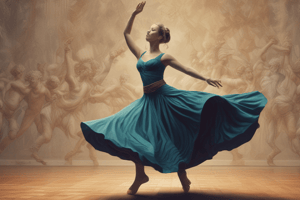Podcast
Questions and Answers
What aspect does choreography primarily focus on?
What aspect does choreography primarily focus on?
- Performing with emotional expression
- Improvisation of dance movements
- Designing sequences of movements (correct)
- Choosing appropriate music
Which element of dance refers to the area in which the dance occurs?
Which element of dance refers to the area in which the dance occurs?
- Space (correct)
- Time
- Body
- Energy
What type of movement is characterized by a smooth and continuous manner?
What type of movement is characterized by a smooth and continuous manner?
- Swinging
- Vibratory
- Sustained (correct)
- Percussive
Which of the following best defines 'energy' in the context of dance?
Which of the following best defines 'energy' in the context of dance?
In which category does a gesture seem to be frozen?
In which category does a gesture seem to be frozen?
What does the 'body' element of dance focus on?
What does the 'body' element of dance focus on?
Which element of dance is concerned with the rhythm and speed of movements?
Which element of dance is concerned with the rhythm and speed of movements?
What kind of movements are described as having a distinct start and conclusion?
What kind of movements are described as having a distinct start and conclusion?
Flashcards
Dance Definition
Dance Definition
Dance is an expression of the body, usually accompanied by music, displaying emotions and stories through movement, often connected to events like birth, death, etc.
Choreography
Choreography
Choreography is the art of designing sequences of movements in dance, arranging steps, patterns, and routines with music or sound.
Dance Element: Body
Dance Element: Body
The dancer's body is the instrument in dance, focusing on its shapes, movements, and actions.
Dance Element: Energy
Dance Element: Energy
Signup and view all the flashcards
Dance Element: Space
Dance Element: Space
Signup and view all the flashcards
Dance Element: Time
Dance Element: Time
Signup and view all the flashcards
Sustained Movement
Sustained Movement
Signup and view all the flashcards
Percussive Movement
Percussive Movement
Signup and view all the flashcards
Vibratory Movement
Vibratory Movement
Signup and view all the flashcards
Swinging Movement
Swinging Movement
Signup and view all the flashcards
Suspended Movement
Suspended Movement
Signup and view all the flashcards
Collapsing Movement
Collapsing Movement
Signup and view all the flashcards
Study Notes
Introduction to Dance
- Dance is an expression of the body, often accompanied by music.
- Dance is a form of art, showcasing body movement.
- Dance can express emotions like birth, death, marriage, and war.
- Choreography is the creation and arrangement of dance sequences, steps, patterns, and routines to music.
- Choreographers collaborate with dancers to bring artistic visions to life.
Background of Dance
- Prehistoric dance was used to supplicate gods on important occasions.
- Mediterranean and Middle Eastern civilizations used dance for worship.
- Ancient Egyptians used carvings and literature to record dance.
- Ancient Greek dance was categorized as Noble (aesthetic) and Ignoble (vain), often used for recreation and entertainment.
- In Ancient Rome, dance was viewed as a waste of time, and its art form was deemed less valuable.
- During the Dark and Early Middle Ages, public dancing became popular, with round and pair dances being favored by farmers.
- During the Renaissance period (15th and 16th centuries), new dance styles, including ballet emerged.
- New dances appeared and were developed during the height of ballet fame
Styles of Dance
- The presentation showed common dance styles, including Ballet, Contemporary, Jazz, Folkdance, Modern, Hip-Hop, Ballroom, and Cheerleading.
Ballet
- Ballet is often considered the backbone of dance.
- Ballet uses specific techniques and requires dedication for perfect execution.
- Ballet is categorized as Classical, Neoclassical, and Contemporary.
Classical Ballet
- It is a formal style.
- It follows traditional ballet techniques.
Neoclassical Ballet
- Evolved from classical ballet.
- It is abstract in form.
- It emphasizes athleticism and strong moves.
Contemporary Ballet
- Inspired by classical ballet and incorporates modern jazz techniques.
Contemporary Dance
- Combines modern, ballet, and jazz elements.
- Used to freely express feelings.
Jazz Dance
- It's a lively and enthusiastic dance style, naturally combined with upbeat music (like hip-hop).
- Jazz adds theatrical flair.
Traditional Dance
- Dance that serves leisure, ceremonial, or traditional purposes in a community.
Modern Dance
- Evolved in the 20th century as a response to classical ballet.
- Modern dance differs drastically from ballet.
Hip-Hop Dance
- A popular and diverse style of hip-hop.
Elements of Dance
- Body: The dancer's instrument, including shapes, movements, and actions.
- Energy: The quality of movement (force, flow, dynamics).
- Space: The area where the dance occurs (direction, level, size, pathways).
- Time: The dance's rhythm, speed, and duration (tempo).
Dance Qualities
- Sustained: Smooth and constant movements without distinct start/finish.
- Percussive: Violent or acute movements with a clear start and end, often using footwork.
- Vibratory: Restless effect created by quick shaking movements.
- Swinging: Characterized by curved or arched motions.
- Suspended: Frozen gestures.
- Collapsing: Motions that show a gradual or abrupt sinking to the ground.
Studying That Suits You
Use AI to generate personalized quizzes and flashcards to suit your learning preferences.




